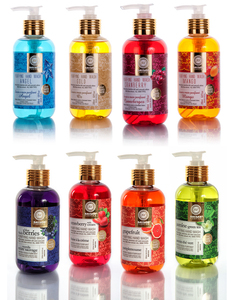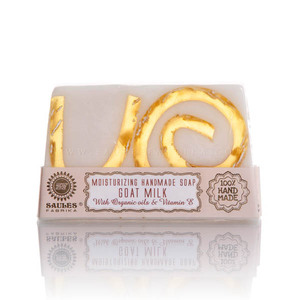(51 products available)
























































































































































































Different types of soaps can be found in Riga, Latvia. Each has unique properties and characteristics that make them special. Below are some of the types of soaps that can be found in Riga:
Natural soaps
Natural soaps are made with natural ingredients. These ingredients include essential oils, such as olive oil, coconut oil, palm oil, and butter. They are used to make the soap base. Other ingredients like shea butter, honey, and oatmeal are added to give the soap more moisturizing properties. Natural herbs and essential oils are also added to give the soap its fragrance. They are more beneficial than commercial soaps because they have a high concentration of natural ingredients. They are great for people with sensitive skin and are also suitable for everyday use.
Organic soaps
Organic soaps are made from plant-based oils and fats. They are made from organic ingredients that are grown without pesticides or any form of chemicals. The organic ingredients used in the soap have antioxidant and anti-inflammatory properties. They help to soothe, repair, and protect the skin. Organic soaps are free from synthetic chemicals and are not tested on animals. They are biodegradable and more environmentally friendly. They are ideal for people who prefer a more natural lifestyle.
Moisturizing soaps
Moisturizing soaps are made with a soap base that has high amounts of natural glycerin. Glycerin is a known humectant that attracts moisture to the skin. It prevents the skin from drying out and keeps it soft and smooth. Some common ingredients found in moisturizing soaps are shea butter, cocoa butter, olive oil, and almond oil. They have excellent moisturizing properties and are ideal for people with dry skin.
Aromatic soaps
Aromatic soaps are made with essential oils derived from plants, flowers, and spices. They have a soothing effect on the mind and body when used. Some common essential oils used in making aromatic soaps are lavender, eucalyptus, lemongrass, orange, and mint. They are known for their aromatic and therapeutic properties. Lavender soap has a calming and relaxing scent and is suitable for everyday use. Eucalyptus soap has a fresh and clean scent and is ideal for use during the cold and flu season.
Exfoliating soaps
Exfoliating soaps are made with ingredients that have coarse particles. These particles help exfoliate the skin when the soap is used. Some of the ingredients used in making exfoliating soaps are oatmeal, coffee, pumice stone, and fruit seeds. They help remove dead skin cells and improve blood circulation to the skin. They are ideal for people who want to achieve smooth and glowing skin.
Skin Type:
Identifying the skin type is important for choosing the right soap. For dry skin, moisturizing soaps with ingredients like glycerin, coconut oil, or shea butter are ideal, as they help lock in moisture. For oily or acne-prone skin, soaps with tea tree oil, salicylic acid, or natural astringents are suitable, as they clean the pores and control excess oil production. For sensitive skin, soaps with chamomile, oatmeal, or hypoallergenic ingredients are appropriate, as they soothe the skin and reduce redness.
Ingredients:
It is important to choose soaps with natural ingredients and avoid harsh chemicals. Look for glycerin soap riga, which contains vegetable glycerin and natural oils. Avoid soaps with parabens, sulfates, or synthetic fragrances, as they can cause skin irritation or allergic reactions. Instead, choose soaps with essential oils, herbal extracts, and moisturizing agents that are gentle on the skin.
Benefits:
Different soaps offer different benefits. For example, moisturizing soaps hydrate dry skin, while exfoliating soaps remove dead skin cells and promote circulation. Antibacterial soaps kill acne-causing bacteria, and aromatic soaps relax the mind and body. Choose soaps that suit the skincare needs and desired benefits.
Allergies:
Soaps with common allergens like fragrances, nuts, or certain plants should be avoided if they trigger any known allergies. Instead, opt for hypoallergenic soaps or those with a shorter list of ingredients. Read the label carefully to ensure that no potential allergens are included.
Sustainability:
Choose soaps from brands that support sustainability and ethical practices. Look for soaps packaged with eco-friendly materials or plastic-free packaging. Also, choose brands that support fair trade and use ethically sourced ingredients. This way, the environmental impact can be reduced while supporting positive global change.
Aroma:
Soaps with essential oils or natural ingredients generally provide a pleasant aroma. The scent of soap can affect the choice. Some people prefer unscented or mildly scented soaps, while others are drawn to particular fragrances. Choose an aroma that suits the personal preference and creates a positive experience during the bathing routine.
Soap from Riga is versatile and can be used on the face, body, and hands. Some manufacturers provide instructions on how to use the soap. Below is a step-by-step guide on how to use the soap.
How to use soap bars
Wet the bar of soap and then create lather by rubbing it on the skin or by rubbing it on the hands. Apply the lather on the skin and focus on the body folds, behind the ears, underarms, and face. Once done, rinse the soap off with clean water and pat the body with a clean towel.
Users may need to apply soap savers or dishes under the soap bar to prevent them from melting away.
How to use liquid soap
Pump the liquid soap on the hands and rub the hands together to create lather. Apply the lather on the face, neck, and body. Rinse with water. Liquid soap is also great for washing dishes and laundry.
How to use exfoliating soaps
Exfoliating soaps are rough, and it’s best to use a washcloth or loofah to create lather. Gently scrub the skin in a circular motion to promote blood circulation. Be gentle when using the soap on the face, as it can be harsh.
Many manufacturers of Latvian soaps indicate product safety information on the packaging. The information includes the ingredients, safety precautions, and expiry date. The product safety information helps users understand the product better. For instance, the safety precautions indicate what the soap shouldn't be used on, while the ingredients list what the soap is made of. Also, the expiry date ensures the soap is used before it expires.
Riga soap has several features, functions, and designs that make it an attractive option for buyers. Some of them are listed below.
Q1: What are some benefits of Riga soap?
A1: Many Riga soaps are made from natural ingredients that nourish the skin. The oils moisturize the skin, while herbal extracts such as chamomile and aloe vera have soothing properties. The soaps cleanse well without removing the skin's natural oils. Many Riga soaps do not contain artificial scents or chemicals. Their gentle formula suits most skin types, including sensitive skin.
Q2: What is the shelf life of Riga soap?
A2: The estimated shelf life of Riga soap is between 12 months and 3 years. This depends on the ingredients and how one stores the soap. Natural soaps with a high percentage of organic ingredients have a shorter shelf life. This is because they lack preservatives. However, synthetic soaps can last up to 3 years due to the presence of preservatives.
Q3: How should one store Riga soap?
A3: Proper storage can make Riga soap last longer. Always keep the soap in a dry, cool place. Moisture can make the soap dissolve quickly. It also creates an environment for mold growth. Wrap the soap in its original packaging. If it does not come with any packaging, wrap it in wax paper. This helps to keep dust away. Avoid direct sunlight, as it alters the color and scent of the soap.
Q4: Can buyers get samples of Riga soap?
A4: Many manufacturers offer samples to buyers upon request. Some provide them for free, while others require that buyers pay a small fee or the shipping costs. Getting samples is an excellent way for buyers to assess the quality of the soap before making a bulk order.